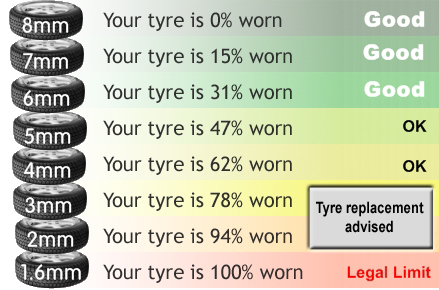Tyre safety
Helpful information on tyre safety
Car tyres
About Tyre safety
The size of your tyre ‘footprint’ on the road is about the size of a postcard. Therefore having the right tyres, with the correct tread and pressure, is vitally important as they are your vehicle’s only contact with the road surface. The more tread, the better the grip on the road, whatever your speed or weather conditions.
Further information and tips
Tyre tread and the law:
- The legal minimum limit for tread depth on tyres is 1.6mm over the central three quarters of the tyre around the complete circumference (In some countries on the continent the legal minimum tread depth is 3mm)

Tyres and stopping distances:
- The more tread you have the quicker you stop
- In wet weather stopping distances double
- In snow or icy conditions stopping distances can increase by up to ten times
Tyre pressures:
- Tyres must be correctly inflated to the vehicle manufacturer’s specification for the load being carried (Always refer to the vehicle’s
- handbook for the correct pressures for your vehicle)
- Check tyre pressures weekly when tyres are cold as warm or hot tyres can give a false reading
- Tyres should be free from cuts and other defects
Coping with a burst tyre:
- If a tyre bursts while you are driving, try to keep control of your vehicle by gripping the steering wheel firmly and allow the vehicle to roll to a stop at the side of the road
Coping with a flat tyre:
- If you have a flat tyre, stop as soon as it is safe to do so. Only change the tyre if you can do so without putting yourself or others at risk – otherwise call a breakdown service
